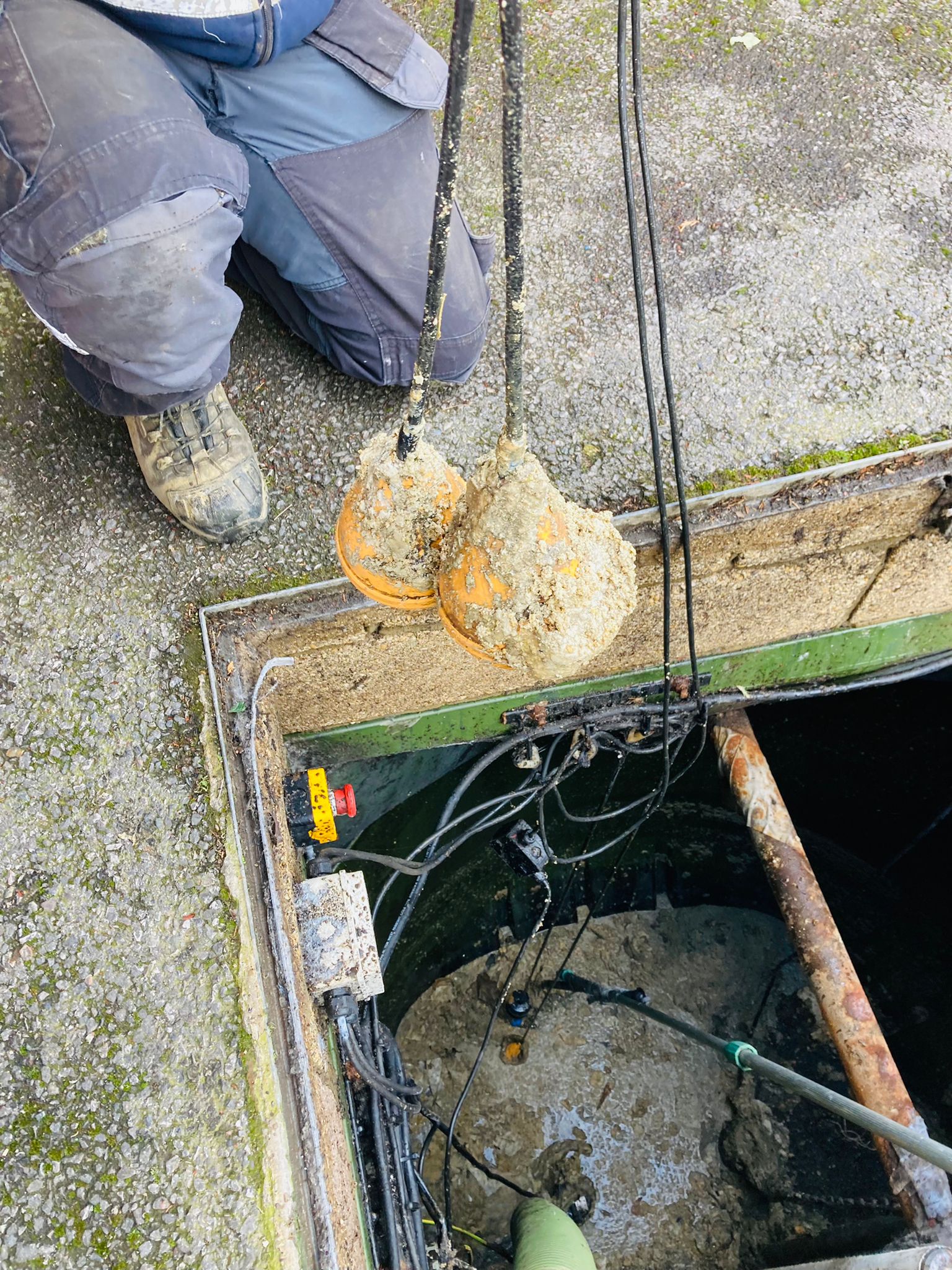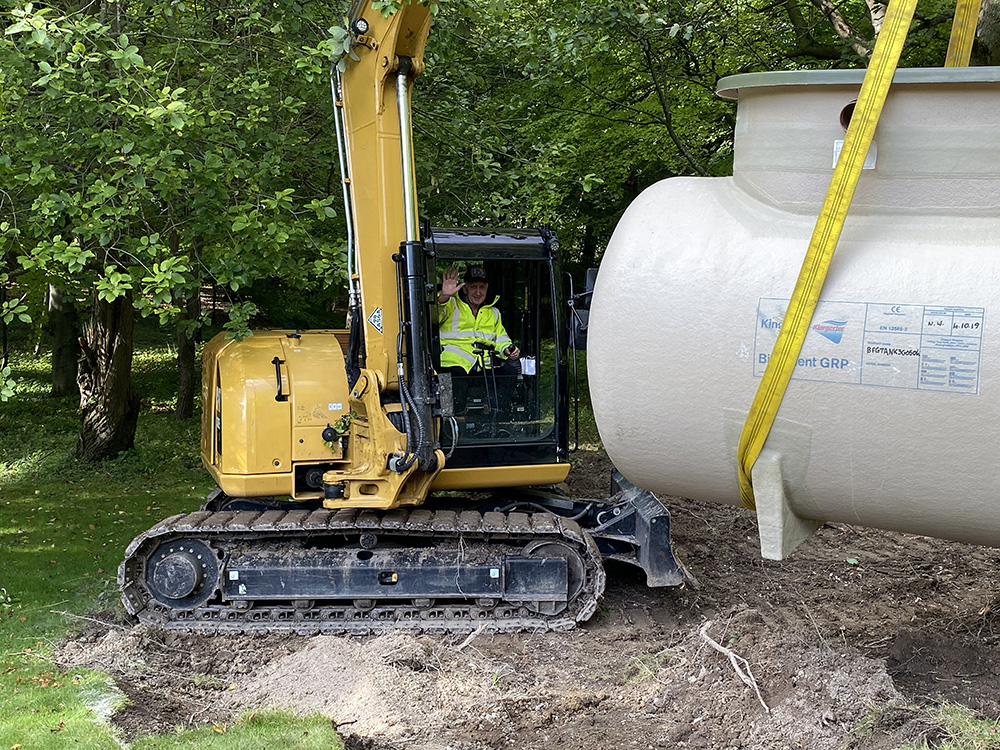Sewage pumping station fatigue: Why they implode.
Solid materials that make a treatment plant, pumping station, or septic tank can experience fatigue, especially if used for anything other than what they’ve been designed for.
In the case of a pumping station, if the tank has not been properly installed i.e.
- The invert level is too deep for the tank, diminishing the capacity;
- You have bought a cheap pumping station, or the float switches have been set incorrectly;
- Or You’re pumping station maintenance crew is not informing you of fat coating the float switches;
A cheap tank can end up being a very expensive one.

IMAGE LEFT: This is a picture of the float switch covered in fat that stopped the pumping station functioning. It caused the maintenance team, including the sewage tanker, to attend as an emergency. If it had been allowed to empty down and we hadn’t stopped the pumps, they could have run dry and burned out. Float switches covered with fat are not dependable.
Tanks are designed for a purpose.
They have a certain capacity to suit the usage – for example: if a house has five bedrooms, there is the potential for maybe ten people to be using the system. Therefore the capacity of the tank should be determined by the potential usage of full occupancy.
Roof water during a heavy downpour can accumulate 10 x times the number of household users in 24 hours, and if this is getting into the sewage system (indirectly or directly), it can cause a massive amount of movement, destroying baffles and separation.
Septic tanks, for instance, are fully functional when they fill up to roughly 3/4 of the tank; once the liquid has reached this level, the separated water flows into a pipe that leads to the drainage field or land drains. This is how it should function, with little or no tank movement for six months or even a year (in some cases, several years). No movement equals less fatigue or no fatigue!
A common cause of tank fatigue
Internal baffles may be damaged by fatigue when fat congeals and ends up similar to a ‘fatberg’ (a crust or rather a heavy floating mass of fat mixed with some sewage); often, advice is given to avoid this, but it is very hard for owners to grasp how fat builds up when it seems they are unaware of it going down the drain.
Read more about septic tanks in our blog article entitled 'What is a septic tank'.
An example case in point of tank fatigue
New houses being installed: one of the conditions was to have a tank installed for roof water recycling, supplying the house facilities such as the WC et cetera with the recycled water. Mains water was connected to the tank as a backup plan if there was no rain.
Consequently, during long periods of “no rain”, the tank was frequently emptied by the occupants of the house, triggering the mains water to fill the tank. The whole process would start once again the next day.
The tank acted as a human lung; “in-and-out” daily “in-and-out”. The movement caused the tank to implode, causing stress to the material as it was too weak for the application. Fatigue and cracking occurred in all of the installed tanks, eventually resulting in them all collapsing. You could see the actual impression of the tank in the concrete, like a mould. The tank was never designed to adhere to the concrete.
Installing a sewage tank in the ground
Surrounding the tank in concrete holds the tank in place (in the ground) and protects the tank from debris, but not from fatigue.
If done properly, surrounding the tank in concrete will hold it in place (in the ground) and protect it from debris. It will not pop out of the ground when emptied by a tanker as a result of the ground being flooded, as a result of a blockage, or ground that has a high water table; (It’s unlikely that a septic tank would be installed in an area with a high water table) However, If the tank is made of weak materials, the concrete will not stop the tank from imploding or protect it from fatigue.
Read more about septic tank emptying in our blog article entitled 'Septic Tank Emptying'.
How can this be resolved?

When a treatment plant or a pumping station is delivered, we have a machine there to lift the tank off the lorry – if there is a defect, it means rearranging the team's work - transporting the diggers to the next job or back to the yard.
The unit is then to be sent back to join the queue at the manufacturers for the sake of a small repair or reinforcement. It’s not worth the effort, and no one will pay for the disruption. No one seems to want to take responsibility.
Here at ASL Limited, we can improvise. We have a small repair team which are quite used to doing alterations or repairs, even after the installation. It’s common for other busy installation teams on a tight budget to leave these adjustments or small repairs, often never to be discovered; the treatment plant struggles with these defects that often degrade the quality of the discharge.
So if you need an installation or are noticing issues with your pumping station, treatment plant or septic tank don't hesitation to give us a call on 0800 181 684

